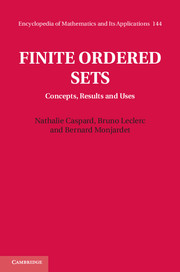Book contents
- Frontmatter
- Contents
- Preface
- 1 Concepts and examples
- 2 Particular classes of ordered sets
- 3 Morphisms of ordered sets
- 4 Chains and antichains
- 5 Ordered sets and distributive lattices
- 6 Order codings and dimensions
- 7 Some uses
- A About algorithmic complexity
- B The 58 types of connected ordered sets of size at most 5
- C The numbers of ordered sets and of types of ordered sets
- D Documentation marks
- References
- List of symbols
- Index
4 - Chains and antichains
Published online by Cambridge University Press: 05 February 2012
- Frontmatter
- Contents
- Preface
- 1 Concepts and examples
- 2 Particular classes of ordered sets
- 3 Morphisms of ordered sets
- 4 Chains and antichains
- 5 Ordered sets and distributive lattices
- 6 Order codings and dimensions
- 7 Some uses
- A About algorithmic complexity
- B The 58 types of connected ordered sets of size at most 5
- C The numbers of ordered sets and of types of ordered sets
- D Documentation marks
- References
- List of symbols
- Index
Summary
The problems of sorting, searching, and scheduling encountered, for instance, in computer science and operations research frequently involve the determination of the width of some ordered set; that is, the maximum size of its antichains. Two illustrations of this general observation are given (Example 4.28 and Exercise 4.2). Thus, this chapter is devoted to the study of the width and to some related topics. First, Dilworth's Theorem states that, in any ordered set P, the minimum number of chains in a chain partition of P is equal to its width. This is one of the most famous results in the field of combinatorics, and the subject of the first two following sections. The theorem is stated and proved in Section 4.1, together with its close relatives. Section 4.2 is devoted to its consequences in the special case of bipartite ordered sets and points out its equivalence to König–Egerváry's Theorem on matchings and transversals in such a structure. In Section 4.5 the importance of this equivalence is emphasized. Especially it leads to an algorithmic determination of the width, by means of results on flows in graph theory. It is moreover recalled that Dilworth's Theorem is also equivalent to three fundamental results of combinatorics, namely the König–Hall, Menger, and Ford and Fulkerson theorems. These results are quite essential and have many practical applications, for instance on binary matrices or allocation problems for the first one (Exercise 4.6) and on transportation networks for the other two.
- Type
- Chapter
- Information
- Finite Ordered SetsConcepts, Results and Uses, pp. 107 - 129Publisher: Cambridge University PressPrint publication year: 2012



